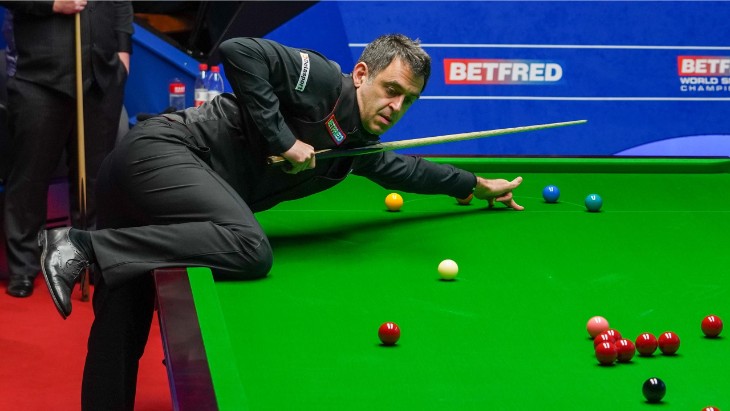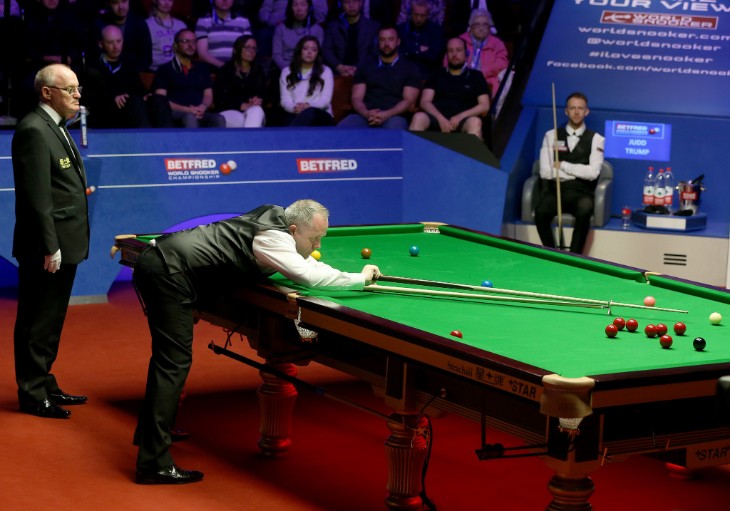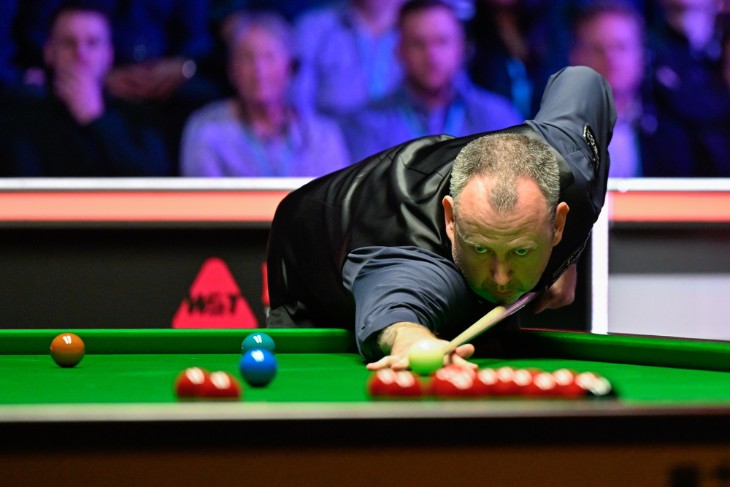Advanced positional play techniques are the hallmark of mastery in snooker, distinguishing exceptional players from the rest. Beyond merely potting balls, these techniques involve intricate control of the cue ball's movement and spin to achieve optimal positioning for subsequent shots. From screw and stun shots to side spin, cannon play, and break-building strategies, advanced positional play encompasses a repertoire of skills essential for navigating the complexities of the game with precision and finesse. Let’s check the intricacies of these techniques, exploring their significance in elevating players' performance and strategic prowess on the snooker table.
Screw and Stun Shots
When we talk about the most common techniques in Snooker, it’s hard not to start with things called screw and stun. These shots are quintessential. The first one, the screw shot, is all about striking the ball below the centre and making it spin backwards. We use this technique to position the cue ball for the next shot by pulling away from the object ball.
When it comes to a stunning shoot, things are pretty straightforward. It’s all about hitting the cue ball at its centre, which will cause the cue ball to stop dead after contact with the object ball. In that way, we can ensure that the ball cue ball movement remains minimal.
The thing with these two techniques is that they require a lot of practice to be learned properly. Moreover, it’s also required to understand the mechanics of the shots. The whole technique requires a pretty comprehensive approach. Players are required to learn a proper stance, grip and cue action. Only in that way they can develop consistency and reach the desired level of accuracy. With practice, players will learn to gauge the proper amount of force required for specific scenarios, as well as to control the speed and spin of the cue ball, to achieve positional play on the snooker table.
Highlights:
Screw shots involve hitting below the centre of the cue ball to draw it back, while stun shots require hitting the centre to stop it after contact.
Mastery of screw and stun shots is essential for controlling the cue ball's movement and spin with precision.
Developing proficiency in these techniques involves practising proper stance, grip, and cue action, as well as learning to gauge force and adjust angles for different shot scenarios.
Side Spin (Sidespin)
The side spin, or just sidespin in snooker, gives the player with the cue stick a tool to change the path of the cue ball with the help of side rotation of the ball when hitting it with the cue stick. This can only be done by hitting beside the cue ball and not in the central part. So, as the ball travels over the table through the balls or cushions, it starts to curve in the direction of the sidespin creating an unpredictable trajectory after hitting the object balls or the cushions. Thus, applying a side spin helps players send the cue ball to the opposite cushion at a certain angle of reflection, pass the balls, and create a proper line of ball position. Left and right side spin can be applied to the cue ball, with each producing a different effect on its path.
Mastering the use of sidespin involves becoming skilled through practice, accuracy, and learning the inner workings of this technique. More specifically, one needs to acquire the ability to strike the cue ball in a way that pushes it off the centerline and precisely calculate its trajectory to achieve the desired level of spin. This also implies other sides of skill development, such as learning how the strength of a spin alters the cue ball’s trajectory, enabling the player to adjust the angle of the shot and the power behind it. Moreover, players develop the ability to “predict” the angle at which the ball will return from hitting the cushion and use this technique to purposely guide the cue ball across the table.
Highlights:
- Side spin, or sidespin, is a technique in snooker where players apply spin to the sides of the cue ball to control its trajectory.
- Mastery of side spin allows players to alter the angle of deflection off cushions, navigate around obstacles, and create precise positional angles.
- Developing proficiency in applying side spin requires practice, precision, and an understanding of how different amounts of spin affect the cue ball's trajectory. Players must learn to strike the cue ball consistently off-centre and adjust their shots accordingly to achieve desired results.

Cannon Play
Cannon play is another important aspect of snooker that takes place when a player uses the cue ball not for direct hitting by an object ball but as a tool for achieving contact solely. Sometimes, such shots are implemented to scatter clutters, prepare onwards, or utilise cue ball movement with a possibility for further advantage. Cannon sometimes is called carom. By skillfully executing cannons, players can create opportunities to continue their break and accumulate points effectively.
Mastering cannon play necessitates the mastery of three abilities: calling the cue ball with pouring, planning, and understanding the laws of physics. For starters, players must master the ability to discern angles and, in doing so, become equipped with the capability to anticipate how the cue ball will move after colliding with a secondary ball. This implies that they play various cannon situations until they become familiar with how to change the throwing angle and rate. Additionally, players must develop their ability to plan several shots ahead, considering potential cannon opportunities and their impact on the overall positional play.
Highlights:
- Cannon's play in snooker involves making contact between the cue ball and other balls on the table to create strategic advantages.
- Proficiency in cannon play requires precise cue ball control, strategic planning, and an understanding of ball physics.
- Skill development involves practising different cannon scenarios, adjusting shot angles and speeds, and planning several shots ahead to maximise positional advantage and scoring potential.
Using Angles and Routes
Using angles and routes effectively is a critical aspect of advanced snooker play, requiring players to understand how the cue ball reacts to cushions and other balls on the table. It is essential to take into account that the more substantial the contact with the cue ball by another ball, the cushion, or, in this specific case, the more significant the rebound angle. This will help players anticipate the trajectory of the next shot and determine the correct angle for placing the cue ball. Routes refer to the paths the cue ball can take around the table to reach desired positional areas or pot balls effectively.
Skill development in using angles and routes involves a combination of practice, observation, and strategic thinking. Each player must also learn to develop his or her mental capacity to imagine and calculate angles properly. This includes developing the ability to imagine how quickly a ball moves the amount of spin on a ball, and how high a ball will generally bounce after contact. To make full use of these skills, a player must practise spending time on the table, submitting the ball to various angles on each shot, and recording the cue ball’s movement response in the process orders of bounce-off. A player must also learn to imagine many scenarios in finding the right way to bank the balls into pockets.
Highlights:
- Understanding angles is essential for predicting the cue ball's trajectory after making contact with other balls or cushions.
- Mastery of using angles and routes allows players to plan shots strategically, positioning the cue ball for subsequent shots or potting balls effectively.
- Skill development involves practising visualising and assessing angles accurately, as well as planning multiple potential routes around the table to navigate obstacles and maintain positional control.
Judgement of Speed and Distance
Break-building skill development encompasses multiple aspects that players need to develop, such as cue ball control, shot choice, and pattern recognition. The ability to pot balls is paramount, as every successful pot allows a player to find another opportunity to continue the break. Cue ball control shot accuracy, and angle deflection after contacting the cushions are other important nuances to keep in mind. Moreover, the player must consider the possible lines of the cannon if the cue ball strikes a specific part of the object ball. While developing one’s break-building techniques, players also develop their strategic thinking in the game. The planning horizon extends, and players actively play for several moves ahead to continue the break since there are several more possible sequences for continuing the attack.
It should be realised that developing skills in judgement of speed and distance will take a lot of time, practice, and observation. Players need to spend hours on the table, trying different movements, and comparing the distance and shot speed with the cue ball performance and behaviour. Only based on observations and changed behaviour, the player can adapt and improve their judgement and perception of the cue ball’s speed and distance calculus.
Highlights:
- Judgement of speed and distance is essential for controlling the cue ball's movement and accurately positioning it for subsequent shots in snooker.
- Skill development involves practising different shot speeds and distances to understand their impact on the cue ball's trajectory.
- Players must refine their judgement through observation and experience, adjusting their approach based on the results of their shots to improve their ability to control speed and distance effectively.
Break-Building
Break-building in snooker is a tactical element of the game in which players attempt to create a frame-winning lead through the sequential potting of balls and effective cue ball position for the next shot. The objective of each player’s break is to score as many points as possible within a single trip to the table. break by potting many balls in a row, while thoroughly controlling the cue ball to continue the scoring. Break-building necessitates a mix of precise potting techniques, shot placement, and planning approaches to ensure the highest scoring potential and take advantage of opportunities over the course of a frame.
Break-building skill development encompasses multiple aspects that players need to develop, such as cue ball control, shot choice, and pattern recognition. The ability to pot balls is paramount, as every successful pot allows a player to find another opportunity to continue the break. Cue ball control shot accuracy, and angle deflection after contacting the cushions are other important nuances to keep in mind. Moreover, the player must consider the possible lines of the cannon if the cue ball strikes a specific part of the object ball. While developing one’s break-building techniques, players also develop their strategic thinking in the game. The planning horizon extends, and players actively play for several moves ahead to continue the break since there are several more possible sequences for continuing the attack.
Highlights:
- Break-building is a strategic aspect of snooker where players aim to construct large scoring breaks by potting balls and positioning the cue ball strategically.
- Skill development in break-building involves mastering precision potting, strategic positioning, and careful planning to maximise scoring potential.
- Players must develop their cue ball control, shot selection, and pattern recognition skills to effectively capitalise on opportunities and continue the break.

Visualisation and Planning
Visualisation and planning are vital skills with snooker that enable players to think several moves long and take away prospects several steps before catching focus planes. In this case, visualisation refers to imagining how the table will look and how players might construct shots, and preparation refers to developing a game plan that allows for optimal position play with maximum exposure. With these skills, players can accurately deal with tough situations and engage shots with precision.
Players must train themselves to visualise the position of balls on the table and anticipate how each shot will affect the layout. This involves mentally mapping out potential routes for the cue ball, considering angles, cushions, and obstacles such as other balls. With practice, players can develop the ability to visualise multiple shot sequences and plan their approach accordingly to achieve optimal position and scoring potential.
Highlights:
- Visualisation and planning are essential skills in snooker, allowing players to anticipate shot sequences and strategise their approach to achieve optimal positions on the table.
- Skill development involves training the mind to visualise the layout of the table and anticipate the trajectory of the cue ball after each shot.
- By mastering visualisation and planning, players can effectively navigate through complex situations on the table, anticipate potential obstacles, and execute precise shots with confidence.
Using Rests and Extenders
Moreover, snooker involves using rests and extenders to make distant shots while retaining control of the cue ball. Rests and extenders are distinct cue extensions that increase the length of the cue stick. This facilitates otherwise impossible shots, allowing players to alter the cue length on a case-by-case basis. Specifically, the rest is also known as the spider and facilitates shots where the cue ball is on the cushion or obstructed by other balls. On the other hand, the extender is also known as the swan neck or the bridge, as demonstrated in Figures 3 and 4 above, the implement utilised for shots where the cue ball is out of the player’s reach. Therefore, utilising rests and extenders allows players to address specific shot conditions without losing positional control and progressive skill on the table.
Skill development in using rests and extenders involves practising proper technique and maintaining stability while using these cue accessories. Players must first familiarise themselves with the different types of rests and extenders and understand when each one is appropriate to use based on the shot at hand. Additionally, players must develop their ability to hold and position the rest or extender steadily to ensure accurate cueing and control over the cue ball. With practice, players can improve their proficiency in using rests and extenders, allowing them to execute shots with confidence and precision even when faced with challenging positional situations.
Highlights:
- Rests and extenders are specialised cue accessories used in snooker to reach distant shots and maintain control over the cue ball.
- Skill development involves practising proper technique and maintaining stability while using rests and extenders to ensure accurate cueing and control.
- By mastering the use of rests and extenders, players can effectively adapt to various shot scenarios and maintain their positional control on the table, enhancing their overall performance in the game.
Summary
In conclusion, the development and mastery of advanced positional play techniques are fundamental to successful snooker players. They enable a performer to deftly and skillfully move a cue ball around the table while ensuring its accurate positioning for the next shot. Screw and stun shots, top spin and side spin, cannon play and break-building represent the key components of positional play. In addition, visualisation, planning, judgement of speed and distance, and skillful application of rests and extenders are also critical elements of advanced positional play. Ultimately, only through practising these techniques to perfection and understanding them completely can a snooker player reach the highest level of performance in the sport while demonstrating the full range of its imperceptible to the naked eye intricacies and nuances on the green baize nine-foot table.




.webp)


 (1).webp)




















